Captain Jules “Jay” Hurst, USAR, previously served as the Operations Officer of the USSOCOM Analytic Innovation and Technology Unit and Senior Intelligence Analyst of 1st Ranger Battalion.
For many years, military scientists have contemplated the advent of swarming tactics as an evolution within maneuver warfare, and futurists have contemplated the execution of the tactics by cooperative teams of semi-autonomous drones.1 These projections expound on strengths demonstrated by hive-minded organisms such as bees or ants, which work cooperatively to defeat larger invaders through non-hierarchal communications. Other swarm theorists reference the deadly effectiveness of the ephemeral, loose formations of horse archers of the Asian steppe against less flexible foes.2 Whatever the source of inspiration, few authors move beyond the abstract employment of robotic swarms. To fully explore swarm utility in fire and maneuver, swarms should be inserted into the tactical concepts of today—chiefly, the five forms of offensive maneuver recognized under Army doctrine.
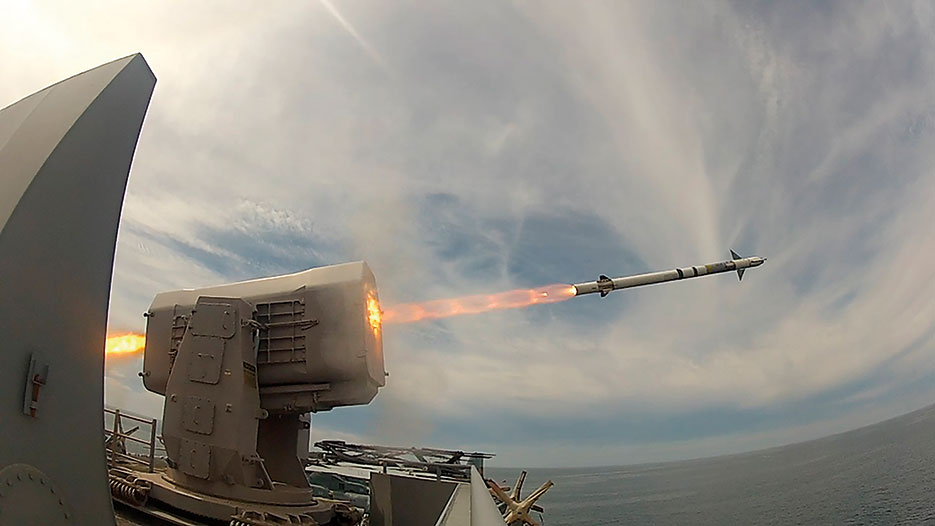
Amphibious assault ship USS America test-fires rolling airframe missile launcher to intercept remotecontrolled drone during exercise to test ship’s defense capability (U.S. Navy/Demetrius Kennon)
Swarm Combatants
Much of the reluctance to begin theorizing about specific swarm tactics stems from the absence of a clear developmental path in the technology. No one knows what swarm combatants will look like or what their capabilities will be, and many prototype pathways exist. Swarm drones could easily take on the appearance of the U.S Navy’s Low-Cost Unmanned Aerial Vehicle Swarming Technology (LOCUST),3 an inexpensive, fixed-wing platform that is individually tube-launched and autonomously joins a swarm once airborne. Alternatively, ground-based swarm combatants might resemble miniature tanks like the Estonian ADDER weaponized ground vehicle.4 For the purposes of this article, though, assumptions need to be made. Future swarm combatants will likely be severable into two broad categories: fire support swarms and maneuver swarms.
Fire support swarm combatants will carry one-time-use warheads that are changed modularly to deal with a variety of targets (area, point, soft-skinned, hardened, airborne, and others). These kamikaze-styled drones could be airborne or ground-based. They might be capable of independently recognizing enemy targets through image classification or need assistance from human controllers. They will likely be individually inexpensive compared to many modern weapons of war, including the precision-guided munitions they may replace. Fire support swarms probably will be initially deployed by conventional field artillery and air assets, but in the future, semi-autonomous systems specifically designed for this purpose may take this mission from them. Something akin to a mini–mobile mortar, self-propelled howitzer, high-flying drone aircraft, or a “truck with rockets” could autonomously move forward with maneuvering elements to deploy responsive fire support swarms.
Theoretically, fire support swarm combatants will be less expensive than precision-guided munitions, capable of targeting without human intervention through object recognition and able to loiter overhead until needed by maneuver forces. Their largest advantage will be numerical. Modern air defense systems are not designed to intercept large quantities of small projectiles, and current missile systems would be overwhelmed if tasked with intercepting a fire support swarm consisting of dozens of munitions.
Maneuver swarm drones will resemble modern air forces and armies on a microscale. Miniature quadcopters armed with light machine guns might act as attack aviation platforms, and scaled-down infantry fighting vehicles will imitate modern armor and mechanized infantry. Flights of fixed-wing swarms will provide persistent autonomous air support as they orbit the battlefield like flocks of angry birds.
Maneuver swarms will likely be more durable than their fire support counterparts and exercise greater cooperation with human combatants on the battlefield. Unlike fire support swarms, maneuver swarms will be persistent and capable of multiple uses. A maneuver swarm might resemble a microcosm of the combined arms forces that have made up militaries since the mid-20th century. They will reflect the synergistic mix of capabilities found there, but they may field air and ground assets in drastically different ratios than are common in today’s Brigade Combat Teams.
Robotic maneuver swarms lack the biggest inhibitor of human combatants—fear. This apathy to casualties would prevent them from having their maneuver restricted by enemy fires, and their ability to field large numbers of swarm combatants offers them a resilience against losing combat effectiveness unknown to human combatants. Maneuver swarms consisting largely of aerial robots would also possess the ability to compress into a space unimaginable by ground-based maneuver units because of their ability to stack vehicles in the air at different altitudes.
Finally, robotic maneuver swarms may offer the best platform to execute reconnaissance pull tactics, a subset of Auftragstaktik or mission-type tactics.5 In recon pull, commanders order units to conduct reconnaissance along the length of the enemy front to determine where to mass forces for the battle’s decisive operation and attempt penetrations or envelopments. A swarm could be particularly effective at this because of its potential to collect big data in real time. Without pause, swarm combatants could relay situation reports faster than any squad leader on a radio. Every soldier may be a sensor, but each swarm combatant will be a sensor platform with an infallible memory.6 A shot fired by or at a swarm combatant provides a data point that, when aggregated, could help the swarm (or human analysts and operators) determine the mass, density, and disposition of enemy forces along its front. With proper processing, this swarm data could provide commanders with a visualization of enemy activity on the battlefield in real time and improve their cognitive ability to perceive a battlefield filled with tens of thousands of robots, human beings, and vehicles.
Imagine the power of thousands of drones gathering combat data in real time and the rapidity with which weak points in the enemy line could be calculated and exploited with a robotic coup d’oeil. Then imagine how quickly these same drones could concentrate in an attack on these points. The potential for a trained swarm to observe, orient, decide, and act faster than human combatants in this scenario is frightening.7 When swarms face one another, the speed of the swarm’s coup d’oeil—determined by algorithmic efficiency and processing power—may decide the outcome of battles, and if robots ever become the military’s primary maneuver arm, a force’s mobile computing capabilities may be a key component in evaluating its overall combat power.
The Role of the Air Force and Naval Aviation
Air Force and Navy assets will play critical roles in the delivery, sustainment, and cyber protection of drone swarms on the land and in the sea and air, but they will also have significant roles in fielding and controlling maneuver swarms in land armies. Fixed-wing systems offer numerous advantages over their rotary-wing counterparts in endurance, speed, and payload capacity due to efficiencies inherent in their aeronautical design. Accordingly, fixed-wing drones should make up a large portion of future maneuver and fire support swarms. Unless ceded to the Army, these armed, robotic fixed-wing platforms will be controlled by Air Force or naval aviation, necessitating that both Services further integrate their mission command of these swarms directly with land forces.
Currently, the Air Force sees maneuvering airpower as a way of adding flanks outside of horizontal battle, but the fielding of large swarms of fixed-wing drones will expand the Air Force definition to include features of Army and Marine Corps concepts of maneuver.8 Unlike historical aircraft, fixed-wing maneuver swarms will have the persistence to take and hold terrain, allowing air forces to execute maneuvers in combat analogous to their land force brethren. Large swarms of unmanned aircraft will be able to orbit for hours, if not days, at a time, raining munitions down on their foes like Mongol horse archers circling in front of (or above) enemy battle lines.9 Aircraft losses from ground fire may be high but acceptable because swarm combatants will maintain low per-unit production costs and not endanger pilots—one of the most expensive combat occupations to train.
Like modern Air Force combat controllers, the Air Force and Navy personnel who control these fixed-wing maneuver swarms will need to integrate into maneuver formations, and Air Force and naval doctrine will change to accommodate their new role in land warfare. Additionally, the required interoperability of automated systems between the automated and unmanned components of different Services will necessitate standardization and joint testing beyond that of most 20th-century weapons systems. In the scenarios in the later part of this article, maneuver swarms function under multi-Service control.
Capability Assumptions. Autonomous swarm technology only exists in nascent stages, but to explore the use of swarms in offensive forms of maneuver, we need to make projections regarding their future capabilities.
Future swarm combatants will possess sufficient artificial intelligence to operate semi-autonomously after receiving initial guidance from human operators. Maneuver or fire support swarms should be able to process tasks of the following complexity without human control:
Attack all adult males within a 500-meter radius of given center point until depleted of ammunition. Return to rally point X at that time OR travel to this geographic coordinate, count all individuals possibly identified as adult males for the next four hours, relay that data in real time, then return to coordinate X OR conduct a reconnaissance in force along a pre-determined route, deviations are authorized if the route becomes impassable. Self-defense authorized if engaged.
Because of their ability to communicate with other members of the swarm while performing other tasks (for example, fighting or moving) without distraction, maneuver and fire support swarms should be able to change formations or dispositions faster than human combatants and exploit this advantage on the battlefield. Their ability to ignore the psychological effects of incoming fire makes this advantage even greater.
Swarm endurance will grow with time, but for now let us assume that swarm combatants possess satisfactory power to sustain operations independent of human support for 12 to 24 hours depending on the intensity of tasks. Charging stations, situation dependent, may be deployable to extend their endurance mid-combat.
Among the hurdles to the success of swarm technology are secure communications. Without intra-swarm communications, maneuver swarms would become the equivalent of a human-wave attack—deadly in scale but incapable of massing at a decisive point with swiftness. Fire support swarms with straightforward attack missions may be less reliant on intra-swarm communications and should be less vulnerable to electronic warfare. For this article, we assume that most future swarm combatants will possess the means to communicate mid-battle, at least to the point where they will be able to intermittently communicate through burst communications or while in close proximity to each other.
Both maneuver and fire support swarms will be vulnerable to cyber attacks by state and nonstate actors. The cyber components of every Service will need to make considerable effort to minimize vulnerabilities of friendly swarms and exploit those of the enemy. To decrease the likelihood of a single software or hardware vulnerability, the Armed Forces will need to avoid overstandardization of software within swarms, which will complicate system interoperability. The cyber battles that enable the kinetic use of swarm combatants will consist of system administrators and information assurance officers updating software patches before enemy forces can identify exploitation pathways in older versions, while friendly forces attempt to do the same to adversaries. Encryption and the rapid updating of cryptography will be another struggle. Communications officers across the joint force may need to update cryptographic keys multiple times a day to preserve information assurance.
Swarm combatants will be deployable into combat from diverse platforms, including but not limited to airdrops, artillery projectiles, cruise missiles, conventional aircraft, and other ground-based motherships.
Deploying armed swarms on the battlefield could easily pose risks to human combatants on both sides. Fratricide is a real risk, especially considering the early state of robotic object recognition. To combat this, both maneuver and fire support swarms will likely have a number of fire support control measures built into their programming prior to employment. These control measures may be geographic (only target enemy personnel in this geographic bounding box), temporal (do not engage targets after 1200 zulu), or beacon-based (do not attack individuals or vehicles broadcasting or carrying X; a similar concept is displayed in the movie Screamers, where soldiers wear a beacon to avoid being targeted by blade-wielding robots who roam the planet10). A redundant approach is likely and recommended.
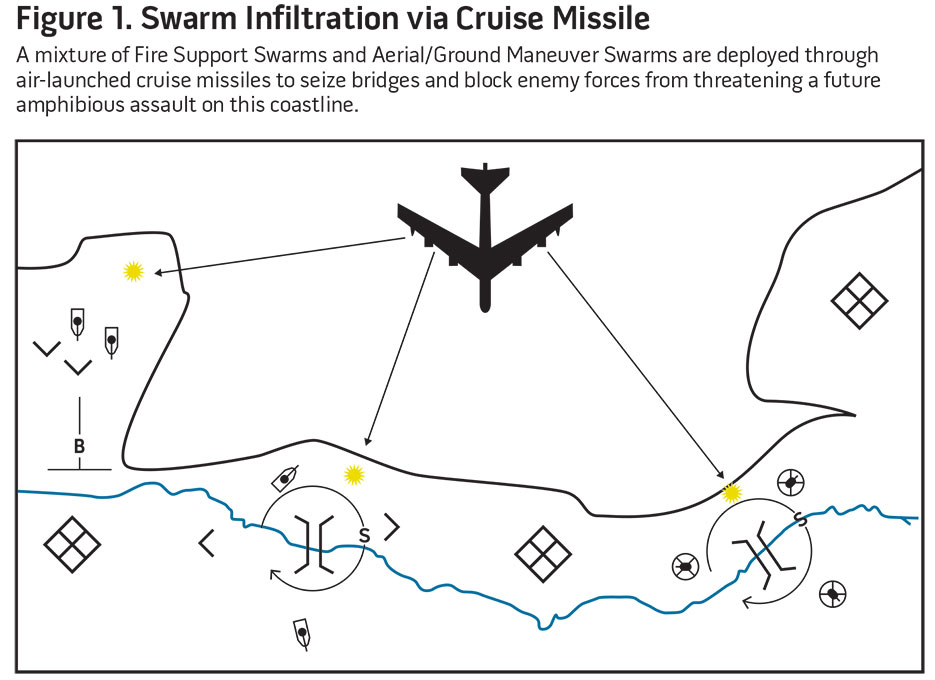
Though deadly, swarm combatants will be just another tool in the joint force commander’s toolbox. Conventional forces will still largely consist of human combatants and manned vehicles for at least the next two decades, but the role of robotic combatants will grow in parallel with their capabilities. One day, semi-autonomous systems may compose the majority of combatants on the battlefield. Still, swarms will not be omnipotent. Weapons carried by infantrymen, manned fighter aircraft, and ships will adapt to the arrival of swarm combatants just like they did to tanks, surface-to-air missiles, and submarines.
Commanders will need variety in their swarm vehicles to effectively accomplish their missions. Swarm combatants may vary in cost from a few hundred dollars (for disposable fire support munitions) to hundreds of thousands (for persistent combatants), all depending on their purpose and desired durability. Some swarm vehicles will be built specifically for identified missions, and others will possess weapon and sensor modularity that allow them to adapt to multifunctional roles across different combat theaters. Most important, as semi-autonomous technology proliferates, commanders will need swarm vehicles capable of engaging traditional maneuver units and other swarms.
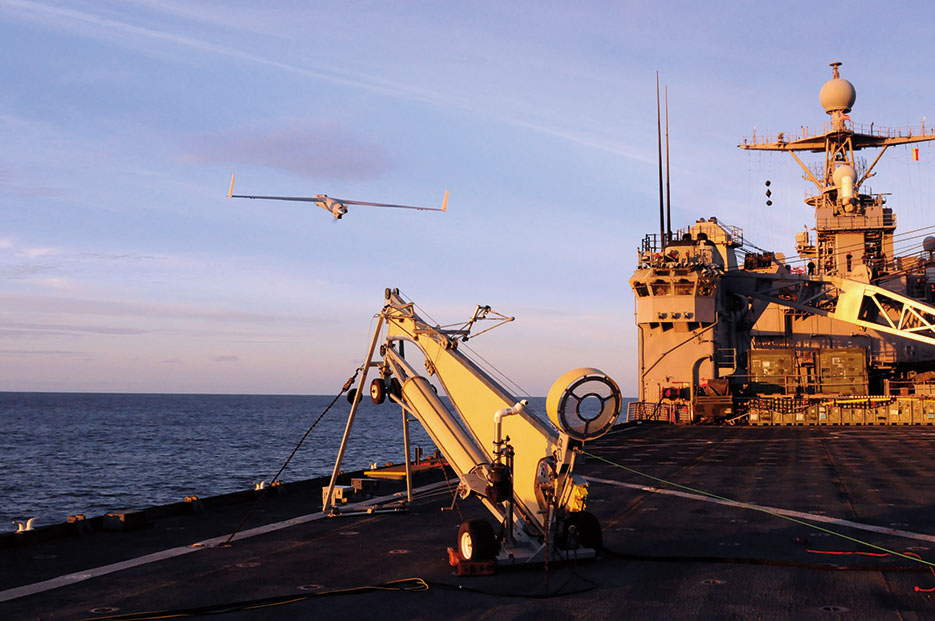
Scan Eagle unmanned aerial vehicle designed to provide multiple surveillance, reconnaissance data, and battlefield damage assessment missions launches from amphibious dock landing ship USS Comstock, February 25, 2011 (U.S. Navy/Joseph M. Buliavac)
Forms of Offensive Maneuver
According to U.S. Army Field Manual 3-90, Tactics, there are five kinds of maneuver used in offensive operations: infiltration, penetration, frontal attacks, envelopments, and turning movements.11 Each offers an opportunity to gain utility from robotic swarms in its own way. In the next section, we explain each of these forms of maneuver, provide historic examples of the movement, and describe a hypothetical use for a robotic swarm inside that type of maneuver.
Infiltration. A favorite of light forces and insurgents, in an infiltration, elements of the offensive force slip behind or through enemy lines to seize advantageous terrain in the enemy’s rear or to sow confusion before the main assault.12 They can also be used to interfere with the enemy’s ability to conduct resupply. In 1968, the Viet Cong famously led thousands of North Vietnamese army units into the South in small groups before launching the Tet Offensive.13 In another example, American and British forces boldly airdropped behind German defensive works in Normandy to seize key bridges and intersections prior to the main assault on the morning of June 6, 1944.14
While airborne forces still offer attractive infiltration options, maneuver swarms will likely be deployable more quickly due to the speed of potential transportation options available. Today, Tomahawk land attack missiles can precisely deploy 166 submunitions from a range of over 1,000 kilometers, traveling at a speed of 550 miles per hour.15 Envision a flotilla of U.S. destroyers launching salvos of these same missiles carrying dozens of maneuver or fire support swarm combatants to seize key terrain prior to an amphibious, airborne, or air assault. These same capabilities could be used to quickly surprise an enemy force mid-battle by suddenly creating a hostile force in the enemy rear. And unlike airborne infiltration or forcible entry operations, a swarm transported via sub- or supersonic missile would lack the observable indicators of a large airborne operation—creation of an air corridor, massing of transportation aircraft—and would reduce the risk to brigades, regiments, or divisions of human combatants.
That being said, swarm infiltrations would likely need human support to achieve any kind of endurance on the ground. Small numbers of human paratroopers might accompany swarms into combat as controllers, maintainers, and installers of charging stations. To hold terrain for any length of time, maneuver and fire support swarms would need a means of refueling behind enemy lines, potentially through air-dropped solar power stations, petroleum generators, or precharged batteries. Swarms would also be unable to handle more complex tasks, such as the neutralization of explosively rigged bridges or the clearing of obstacles; after seizing objectives in Normandy, U.S. and British paratroopers often had to strip charges from infrastructure designed to deny invading Allied forces its use.
Penetration. Penetration attacks are offensive maneuvers that utilize attacks along a narrow front to pierce enemy lines and defensive systems. Once penetration is achieved, forces can either drive forward to an objective behind enemy lines or attack the undefended flanks created by the division of enemy defenses. Penetration movements are often used when flanks are unassailable or well defended or when commanders lack the time to attempt other maneuvers.16 Penetration attacks may also be launched to take advantage of a prominent weakness in enemy defenses. Armies have used penetration tactics since the dawn of warfare. Germanic warriors employed the boar’s head formation to pierce enemy shield walls during the Dark Ages, and medieval knights brought the maneuver into the Middle Ages.17 In a more modern example, British Field Marshal Bernard Montgomery successfully used an armored penetrating attack to win an Allied victory at the Second Battle of Alamein in World War II.18
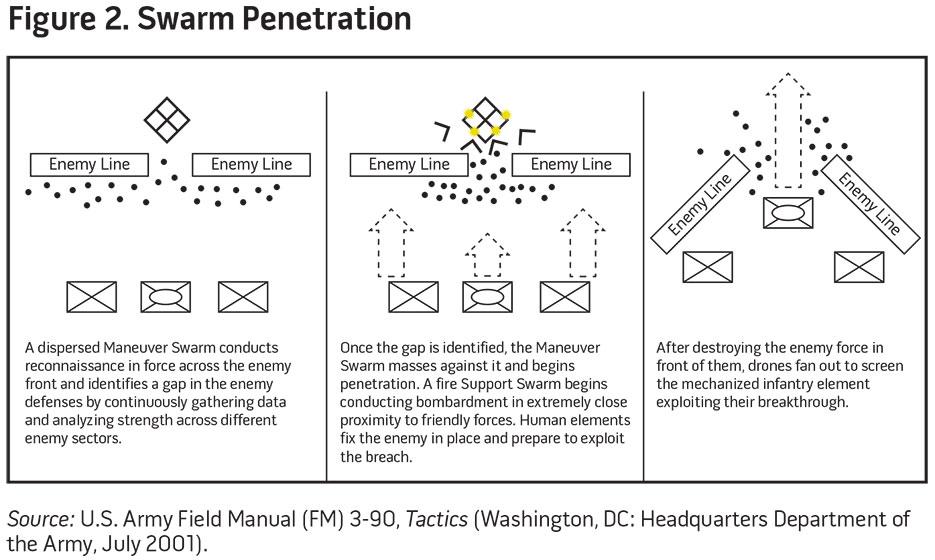
Successful penetration attacks often use extensive indirect fire to weaken enemy defenses or to pin enemy elements in place to prevent them from assisting the section of the enemy line targeted for penetration. Prior to the Old Guard’s failed penetrating attack at Waterloo, Napoleon massed his artillery to weaken the British defenses, but the use of a reverse-slope defense and the arrival of the Prussian army prevented the maneuver’s success.19
In a penetration attack using swarms, maneuver and fire support swarms could work in unison to identify and exploit a weakened section of enemy defenses. Using the robotic coup d’oeil described, maneuver swarms could deploy along the length of the enemy front as skirmishers and gather data on the composition and disposition of enemy forces they encounter. Far behind the frontline, a cluster computer, a series of them, or the computing power of the swarm itself could aggregate the swarm’s observations and identify enemy weakness by examining how many swarm skirmishers were lost in each sector, how fast swarm combatants were expending ammunition, and other observables. Once the weakest sector of the enemy line was identified, maneuver swarms would silently consolidate and mass against it. As they began their assault, a fire support swarm could further degrade defenses in the area, taking the place of an artillery bombardment, and permit a rolling barrage of precision indirect fire support with previously inconceivable speed and proximity to advancing forces—robots do not fear fratricide. Once an initial penetration is achieved, human mechanized forces could exploit the breakthrough and drive the attack onward toward objectives in the enemy’s rear or exploit the newly created disruption in enemy defenses.
Frontal Attack. Likely used since combat took on a modicum of organization, frontal attacks are among the oldest forms of maneuver. Commanders use frontal attacks when they possess overwhelming combat power relative to the enemy to fix hostile forces in place, to destroy a breaking enemy, or to conduct a reconnaissance in force.20 At the Battle of Bunker Hill, for instance, British forces sustained over 1,000 casualties conducting a series of frontal attacks against fortified colonial militiamen defending the hill outside of Boston.21 Many a commander has planned extravagant maneuvers prior to battle, only for a souring situation to force him into a frontal battle of attrition with his foes.

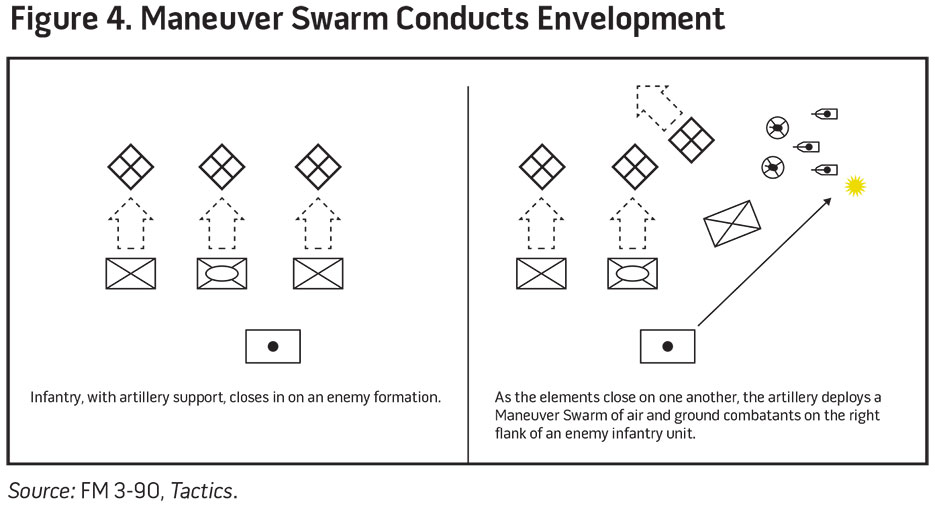
The strength of a robotic swarm lies in its ability to communicate and move faster than human combatants in similar situations, allowing it to surreptitiously overwhelm opponents by massing at an unexpected point. Frontal assaults, depending on the complexity of terrain and the swarm deployment technology used, can make poor use of these attributes. But, as described, the ability of swarm combatants to gather and simultaneously transmit information to the joint force commander will make them highly useful as scouts and as fixing forces. Because commanders will not be as concerned with swarm casualties, they will eagerly commit them to these tasks. And because swarms lack fear and cannot be psychologically pinned down, they will execute them with unrivaled quickness and commitment.
Consider this scenario: Two light infantry forces of equal size stumble upon one another in a meeting engagement. One side deploys several dozen maneuver swarm combatants from a mothership vehicle and pushes them forward in a frontal assault to contain the enemy force and permit human elements to maneuver. These swarm combatants may all be destroyed, but if they give the light infantry force the opportunity to maneuver on a similar-sized force with less risk, they have served their role. Maneuver and fire support swarms will provide commanders with the option to trade robot lives for space and time and will encourage aggressive tactics that might give commanders ordering human soldiers pause.
Envelopment. Envelopments send the attacking force around prominent enemy defenses to seize objectives in the enemy rear or to attack an assailable flank. They come in several forms: single envelopments, double envelopments, encirclements, and vertical envelopments. All forms avoid the enemy’s front, where he possesses the greatest ability to place fires.22 The classic example of a successful double envelopment and ultimately, an encirclement, is Hannibal’s victory over Roman legions at the Battle of Cannae in 216 BCE.23 The ultimate American example is General Robert E. Lee’s sweeping envelopment of General Joseph Hooker’s flank at the Battle of Chancellorsville, a daring tactical maneuver that secured the legend of Stonewall Jackson and Lee in the American military consciousness.24
At their core, successful envelopments require three things: a mobility advantage over an adversary, an informational advantage (the location of an assailable flank must be identified), and strong communications between the enveloping and fixing force. Robotic swarms may provide joint force commanders an edge in all three. As described in the infiltration section, maneuver and fire support swarms will be deployable at near-supersonic speeds from hundreds of miles away. If tactical intelligence, surveillance, and reconnaissance assets could effectively identify the end of an enemy’s flank, a commander could request the expedited deployment of swarm combatants on that flank within minutes from cruise missiles or airdrops, granting tremendous tactical surprise. In addition to their deployment advantage, swarm combatants could again make use of their ability to gather large amounts of data to conduct reconnaissance and send back data that aid human analysts in determining where the enemy flank begins and what, if any, forces are protecting it. Even more frightening, maneuver swarms could be easily deployed by projectile to effect a vertical envelopment of a retreating enemy force and disrupt it sufficiently to allow the pursuing army to destroy it.
Turning Movement. In a turning movement, the offensive force avoids the enemy’s principal defenses and seizes objectives behind the enemy lines with the goal of forcing the enemy to respond by displacing from its current position in whole or in part. Turning movements are often used to force enemy units off advantageous terrain through the seizure of populated areas or supply lines critical to the enemy army.25 James Longstreet famously advocated for Robert E. Lee to execute a turning movement prior to becoming decisively engaged at Gettysburg in July 1863.26 Longstreet hoped to place the Confederate army between George Meade and Washington, DC, forcing the Union Army into a costly attack. Another well-known example is Douglas MacArthur’s amphibious landing at Inchon, which severed North Korean lines of communication and sent the Communist forces back north.27
Swarm combatants would likely best serve a ground commander as a screening force, not as the element conducting the turning movement itself. The swarm’s inability to conduct self-sustainment would make it a poor choice. Without human support, maneuver swarms would not be able to sustain a hostile presence in the enemy’s rear long enough to truly threaten enemy lines of communication.
Instead, maneuver and fire support swarms could be placed between the enemy body and the friendly element conducting the turning movement. The mechanized and aerial mobility of individual swarm combatants would not only allow them to cover wide swathes of terrain but also quickly consolidate to counter any enemy attempt to concentrate against the turning force as it exposes its vulnerable flank to the main enemy force.
Technology Drives Tactics
Ultimately, the technological limitations and advantages of maneuver swarms and fire support swarms will determine their uses in offensive maneuver and, more broadly, the tactics of employing them as a whole. Like all groundbreaking technologies—the tank, aircraft carrier, and submarine, among others—the effectiveness of swarm combatants will increase in accordance with maturation in the technology and warfighter comfort with its use. U.S. officers and noncommissioned officers can accelerate that comfort by beginning to postulate about the use of swarms well before they hit the battlefield. In the vein of aviation visionaries Billy Mitchell and Giulio Douhet, members of the Department of Defense must look forward 10, 20, or even 30 years to when artificial intelligence allows the deployment of swarm combatants on a regular basis. It will take years of field maneuvers to perfect the employment of swarms in combat, and the concepts formed during these exercises may be shattered during the first few hours of war. Even so, the U.S. warfighting community must adopt a venture capital mindset and accept many failures for the few novel ideas that may produce game-changing results. The forms of offensive maneuver will not change any time soon, but the type of units and their range of capabilities will soon be in flux. Welcome the swarm. JFQ
Notes
1 John Arquilla and David Ronfeldt, Swarming and the Future of Combat (Santa Monica, CA: RAND, 2000).
2 Sean J.A. Edwards, Swarming and the Future of Warfare (Santa Monica, CA: RAND, 2005).
3 Eric Limer, “Watch the Navy’s LOCUST Launcher Fire Off a Swarm of Autonomous Drones,” Popular Mechanics, May 24, 2016, available at <www.popularmechanics.com/military/weapons/a21008/navy-locust-launcher-test-2016/>.
4 “Estonian Defence Forces Successfully Tested the First Weaponized Fully Modular Unmanned Ground Vehicle,” Defense Blog, December 3, 2016, available at <http://defence-blog.com/army/estonian-defence-successfully-tested-the-first-weaponized-fully-modular-unmanned-ground-vehicle.html>.
5 Robert Leonhard, The Art of Maneuver: Maneuver-Warfare Theory and AirLand Battle (New York: Presidio Press, 1991), 114.
6 Stew Magnuson, “Army Wants to Make Every Soldier a Sensor,” National Defense Magazine, May 2007, available at <www.nationaldefensemagazine.org/archive/2007/May/Pages/ ArmyWantSensor2650.aspx>.
7 John R. Boyd, “Patterns of Conflict,” December 1986, available at <www.ausairpower.net/JRB/poc.pdf>.
8 Jeff Becker and Todd Zwolensky, “Making Sense of Military Doctrine: Joint and Service Views on Maneuver,” War on the Rocks, July 3, 2014, available at <https://warontherocks.com/2014/07/making-sense-of-military-doctrine-joint-and-service-views-on-maneuver/>.
9 Kacey Deamer, “Two Days Aloft: ‘Vanilla’ Drone Breaks Endurance Record,” Live Science, January 13, 2017, available at <www.livescience.com/57506-darpa-drone-sets-endurance-world-record.html>.
10 Screamers, directed by Christian Duguay (Culver City, CA: Sony Pictures, 1996).
11 Field Manual (FM) 3-90, Tactics (Washington, DC: Headquarters Department of the Army, July 1, 2001), 2-2.
12 Ibid., 3-19.
13 James H. Willbanks, The Tet Offensive: A Concise History (New York: Columbia, 2008).
14 Stephen E. Ambrose, Band of Brothers: E Company, 506th Regiment, 101st Airborne from Normandy to Hitler’s Eagle’s Nest (New York: Simon & Schuster, 2001).
15 “Tomahawk Cruise Missile: United States Navy Fact File,” August 14, 2014, available at <www.navy.mil/navydata/fact_display.asp?cid=2200&tid=1300&ct=2>.
16 FM 3-90, 3-25.
17 Njord Kane, “Viking Battle Tactics: The Boar Formation,” Spangenhelm, June 23, 2016, available at <http://spangenhelm.com/viking-battle-tactics-boar-formation/>.
18 Niall Barr, Pendulum of War: The Three Battles of El Alamein (New York: Overlook, 2006).
19 David Howarth, Waterloo: A Near Run Thing (New York: Phoenix, 2003).
20 FM 3-90, 3-30.
21 Nathaniel Philbrick, Bunker Hill: A City, A Siege, A Revolution (New York: Penguin, 2014).
22 FM 3-90, 3-12.
23 Patrick Hunt, “Battle of Cannae: Carthage-Rome,” Encyclopedia Britannica Online, December 23, 2014, available at <www.britannica.com/event/Battle-of-Cannae>.
24 Stephen W. Sears, Chancellorsville (New York: Mariner Books, 1998).
25 FM 3-90, 3-15.
26 “America’s Civil War: Robert E. Lee and James Longstreet at Odds at Gettysburg,” HistoryNet, June 12, 2006, available at <www.historynet.com/americas-civil-war-robert-e-lee-and-james-longstreet-at-odds-at-gettysburg.htm>.
27 David Halberstam, The Coldest Winter: America and the Korean War (New York: Hyperion, 2008).